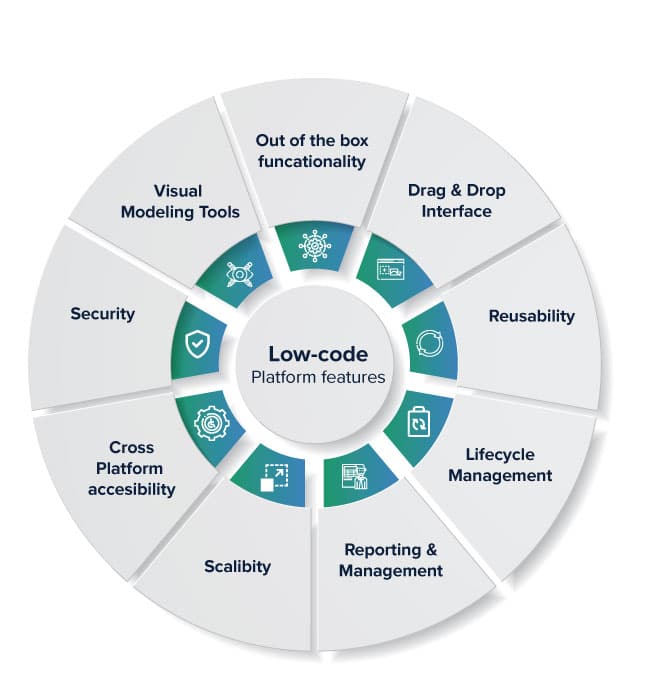Excellent Reasons For Selecting Low-Code Platform Info
Excellent Reasons For Selecting Low-Code Platform Info
Blog Article
Advantages Of Low Code Application Development For Developers Who Are Not Developers.
App development that is low-code improves accessibility by non-developers (often referred to as "citizen-developers") due to a few key factors.
Drag-anddrop Builders: Lowcode platforms include drag-anddrop interfaces to let non-developers create visual applications without the need for codes. This makes it simpler for people who don't have technical backgrounds to get involved in the process of development.
WYSIWYG editors The WYSIWYG editors "What You See Is What You Get" editors allow users to build workflows and interfaces that are identical to the finished version. This makes it easier to understand and use.
Simplified Workflow and Logic Design
Visual Workflow Modeling - Users can develop business processes and logic for applications by using visual flowcharts or models. This is more efficient than traditional programming techniques.
Low-code platforms are often equipped with pre-built logic elements (e.g., conditions loops, statements) which eliminate the need for complicated programming.
Templates and components that can be reused:
Libraries of pre-built templates: Many low-code platforms offer templates for common applications that allow non-programmers to begin with a solid foundation and alter as required.
Reusable Modules and Widgets: With the help of reusable modules and widgets, users can speed up the creation process and reduce the requirement for technical knowledge.
Guided Development and Tutorials
Step-by-Step Instructions Platforms typically offer tutorials that are on screen, guided development pathways, and other tools to help non-developers create applications.
Interactive Tutorials: Interactive, hands-on tutorials allow users to learn through doing, enhancing their knowledge and confidence making use of the platform.
Integration with existing tools
Seamless Integration - Low-code systems can easily be integrated with existing business tools and systems (e.g. ERP, CRM) which gives even non-developers the ability to create apps that fit to their workflows.
APIs and Connectors : APIs built-in and connectors allow users and non-developers to connect their applications to external services without the need for complex programming.
Collaboration Features:
Team Collaboration: Features like real-time collaborative workspaces, as well as shared workspaces make it possible for non-developers to effectively collaborate with developers, business analyst, and other stakeholders.
Role-based access control: Access levels can be set for people who aren't developers to ensure they can still contribute to development, without compromising the security.
Automated Testing and Debugging:
Low-code platforms include tools to test and debug that are built-in. They automate this process, making it simpler for non-developers to make sure their apps run.
Error Highlighting - If issues occur, the system highlights problems and provides solutions. It also guides users through troubleshooting.
The capability of low-code apps to facilitate development to non-developers is their biggest benefit. Low-code platforms are easy to use visual tools, guided experiences, and let business users actively take part in the creation updates, maintaining and enhancing applications. Follow the recommended Low-code Platform for application development tips for blog advice including lowcode no code, app modernisation, push notifications, driver jdbc, cross platform mobile app development, jdbc server, app modernization, develop web app, develop mobile application, jdbc server and more.![]()
Benefits Of Low-Code Application Development In Terms Of Governance And Security
Low-code development of apps offers numerous advantages for governance and security. This is vital to ensure that apps are compliant with rules, are secure, and are well managed throughout their life. Here are a few of the main advantages.
Unified Management Console: Low-code platforms provide a central management console to allow administrators to control and supervise all applications. This helps ensure that the same governance is maintained across the entire organization.
Role-Based Access Control RBAC: These platforms have robust controls based on role that allow administrators to establish access policies. Only authorized users are able to alter or access specific parts of a program.
Compliance and Regulatory Conformity:
A majority of low-code platforms include compliance features. They're designed to comply with industry standards and regulations, like GDPR or HIPAA. They have frameworks and tools which help ensure that the applications are compliant with these standards.
Audit Trails and Logging: Complete logging, audit trails and logs are usually integrated into businesses which allows them to monitor changes and track access. They can also make sure that the organization is in compliance with both external and internal rules and regulations.
Increased Security Measures
Data Encryption Low-code systems typically have built-in encryption for data in transit and at rest, which protects sensitive information.
Security Certifications: A lot of low-code providers have security certifications (e.g., ISO 27001, SOC 2) that demonstrate adherence to high security standards, providing additional assurance to users.
Automated security updates:
Regular Patching and Updates: Low-code platforms typically manage regular patches and security updates automatically, making sure that applications are safe from latest threats without requiring developer intervention manually.
Security Monitoring - Continuous monitoring for security is usually part of the program. This provides real-time insights and alerts about possible security threats.
Data Governance
Data Access Policies: These platforms enable organizations to define and enforce data access policies which ensure that data is only accessible only to those who have been granted access and is used appropriately.
Data Masking and anonymization The tools built into the system to mask and anonymize data help protect sensitive information in development and testing environments.
Consistent Application Management:
Pipelines for deployment and development Low-code platforms provide integrated pipelines for development and deployment which contain security checks. They ensure security is maintained throughout the entire lifecycle of the application.
Version Control: A unified version control system helps to track changes and allows any modifications that are made to an application to be monitored. If needed the changes can be reversed and the integrity of the application maintained.
User Authentication, Authorization, and Authorization
Single Sign-On: Support for SSO as well as other sophisticated authentication methods simplifies the management of users and enhances security.
Multi-Factor Authentication A lot of platforms have built-in multi-factor authentication, providing additional security when accessing apps.
Policy Enforcement and Compliance:
Low-code platforms come with policy templates predefined that can assist organizations in the implementation of governance policies and security policies.
Tools for Compliance Monitoring: These tools track and continuously report on the status of compliance. They make it easier to find problems and address them in a proactive manner.
Integration into Existing Security Infrastructure:
Easy integration: Low-code systems can easily be integrated into the existing security tools and systems such as firewalls and SIEM solutions (Security Information and Event Management), and identity management systems.
API Security: API features which protect data and maintain the integrity of the application are integrated into the API.
Training and the best practices
Guided Best Practices: Many platforms provide guidelines and best practices for secure application development and help non-developers comply with security standards.
Security Training Some low code companies offer security training and resources to users to educate them on how to maintain and build secure applications.
Overall, low-code application developers offer governance and a security advantage that enables them to develop and manage their applications in a controlled, regulated and secure way. These platforms offer the tools and frameworks necessary to protect sensitive data as well as enforce policies and maintain regulatory compliance, all while simplifying management and oversight of the process of developing applications. Read the best her comment is here for Enterprise application development with Low-code Platform for website recommendations including cross platform mobile development, paas service, paas service, cross platform mobile app development, push notifications, develop mobile application, ms azure sql, software for app development, push notifications, azure sql server and more.
The Benefits Of Low-Code Development For The Development Of Applications In Terms Of The Limitations And Customization
Low-code development provides an unbiased approach to dealing with limitations, while also allowing for customization. These are the major advantages: Managing limitations
Overcoming Complexity Barriers
Development simplified: Low code platforms simplify the process by providing templates and pre-built elements. This helps speed up application deployment, even for complicated ones.
Guided Workflows - Many platforms offer wizards or workflows that assist developers with complicated procedures. This reduces the risk of making mistakes and guarantees consistency.
Scalability Solutions
Scalability is built in: Low-code platforms typically include features that enable the development of scalable architecture. Applications can handle increasing demands with little redevelopment.
Performance Monitoring: The tools that monitor and optimize performance help to ensure that applications are efficient, even when they grow.
Security and Compliance
Security features integrated into low-code platforms include security measures such as encryption as well as role-based access control and automated compliance monitoring that address the most common security issues.
Regular Updates: Platforms frequently update their security protocol and compliance measures. This makes sure that applications remain safe from threats that are constantly evolving.
Capabilities to Customize:
Extensibility:
Custom Code Integration : Low-code platforms often allow the integration of customized codes (e.g. JavaScript, Python), which allows developers to enhance the capabilities beyond what is available in the standard features.
Custom Modules and Plugins: Developers have the option to create customized modules or plugins to customize specific functionality to fit unique business needs.
APIs and Integration:
API Support: Comprehensive APIs support is provided to allow seamless integration and connection with external systems.
Third Party Services: Low-code platforms often have pre-built connectors to well-known third-party services, making it easier to integrate and customize applications.
Flexible UI/UX:
User-friendly interfaces that can be customized: Users are able to modify and create their own user interfaces which will provide an experience that is more customized.
Responsive Designs: The applications can be adapted to fit various screen sizes and devices.
Business Logic Customization
Visual Workflow Builders They allow developers to develop complex processes using little or no coding. They can create workflows and business logic visually.
Platforms provide conditional logic that can accommodate certain business requirements or scenarios.
Data Management
Custom Data Models Developers can build custom data models tailored to specific business needs. This means that data handling is customized to each application.
Advanced Data Processor: The integration of sophisticated data processing tools and capabilities permits the customisation of the method by which data is processed and used in the application.
How do you balance customization with limitations:
Frameworks and Standards:
Best Practices in Compliance Low-code platforms promote the use of industry-leading practices and standards. This aids in maintaining high-quality, robust, and secure applications.
Governance Frameworks. Inbuilt frameworks for governance guarantee that modifications will not affect the security, compliance or the integrity of the application.
Iterative Development and Feedback
Rapid Prototyping : Developers can quickly test their customizations and prototypes in response to feedback from users, enhancing the application in line with their preferences.
Low-code platforms are built to enable continuous enhancement. This permits for modifications and improvements as requirements for business evolve.
User Empowerment
Giving Citizen Developers the ability to be empowered by giving non-developers the opportunity to personalize their apps using easy-to-use interfaces and low-code platforms, they boost the number of users who are able to improve and tailor application.
Training and Support: Many platforms provide extensive training and support resources to assist users in making effective customizations without compromising the stability of the application or its performance.
Low-code development is a powerful framework that allows for plenty of customization while addressing any shortcomings. This balance allows companies to build and maintain apps that function, are tailored for their specific needs and adhere to high standards in terms of quality, security, and scalability.